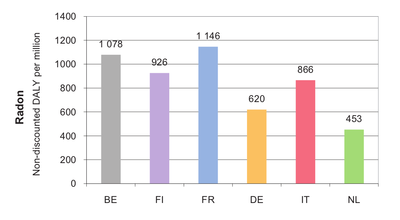Health effects of radon in Europe: Difference between revisions
No edit summary |
Vesigirppu (talk | contribs) No edit summary |
||
| Line 1: | Line 1: | ||
{{study|moderator=Pauli|stub=Yes}} | {{study|moderator=Pauli|stub=Yes}} | ||
[[Category:EDoBE]] | [[Category:EDoBE]] | ||
[[File:radondaily.jpg|thumb|400px|]] | |||
==About radon== | ==About radon== | ||
Revision as of 08:00, 8 June 2011
This page is a study.
The page identifier is Op_en5227 |
|---|
| Moderator:Pauli (see all) |
| This page is a stub. You may improve it into a full page. |
| Upload data
|

About radon
Radon is a short-lived radioactive gas that occurs naturally in soils and rocks. It is generated by the radioactive decay of uranium. Indoor radon concentrations differ based on the characteristics of the geological substrates beneath houses and the use of different building materials.
Exposure to radon can lead to lung cancer. Studies to estimate the risk of lung cancer associated with residential radon exposure have been conducted in many European countries (Lagarde et al. 1997, Bochicchio, 2005, 2008; Darby et al., 2005, 2006). Radon is classified by IARC as carcinogenic to humans (type 1, 1988) with genotoxic action. No safe level of exposure can be determined (WHO, 2000a). Besides lung cancer radon is not known to cause other health effects.
Radon has a synergistic effect with smoking. Epidemiological evidence suggests that the risk of simultaneous exposure to both tobacco smoke and radon is more than additive but that it may be less than multiplicative. [1]
Selected health endpoints and exposure-response functions
Radon effects are usually presented as additional cases of lung cancer at a certain exposure (i.e. unit risk model). In order to account for the interaction with smoking, however, a relative risk model seems more appropriate. We therefore calculated results using both a unit risk model and a relative risk model (method 1A and 2A). The RR method (1A) is used in the final aggregate results. The radon UR model (UR=6.6E-07 (Bq m-3)-1, Darby et al., 2005) is used for comparison of UR and RR modelling approaches in Chapter 5.
The relative risk model, as suggested by the meta-analysis of Darby et al. (2005), assumes the lung cancer risk from radon to be linearly proportional to the radon exposure, but also to the background lung cancer rate caused by tobacco smoking (and, to a lesser extent, by exposure to second-hand smoke, ambient air particulate matter and possibly some occupational exposures) (see Table 3-19 in section 3.12 for the RR values). [1]
Exposure data
The soil uranium contents and respectively the residential radon concentrations vary significantly between the countries. Yet the differences within the countries are still far greater, and the indoor radon concentrations in individual buildings are essentially impossible to predict. Long-term average indoor radon concentrations, however, are relatively easy to measure and are therefore better known and comparable between the countries than those of any other indoor air contaminant.
EBoDE uses the national residential radon exposure estimates as collected by the EU RadonMapping project (http://radonmapping.jrc.ec.europa.eu; country reports available from http://radonmapping.jrc.ec.europa.eu/index.php?id=37&no_cache=1&dlpath=National_Summary_Reports, accessed 11 June 2009). and the UNSCEAR 2000 Report, as presented in Table 3-14 and summarized in Table 3-21 in section 3.12. No further national data collection was conducted, but some additional international data sources were identified, notably from the WHO Radon project (IRP, 2010). [1]
| Country | AM
(Bq m-3) |
GM
(Bq m-3) |
GSD | % (of people exposed) › ≥200 Bq m-3 | % (of people exposed) › ≥400 Bq m-3 | Max
(Bq m-3) |
|---|---|---|---|---|---|---|
| Belgium | 69 | 76 | 2.0 | 0.5 | 4 500 | |
| Finland | 120 | 84 | 2.1 | 12.3 | 3.6 | 33 000 |
| France | 89 | 53 | 2.7 | 8.5 | 2.0 | 4 964 |
| Germany | 50 | 40 | 1.9 | 3.0 | 1.0 | 10 000 |
| Italy | 70 | 52 | 2.0 | 4.1 | 0.9 | 1 036 |
| The Netherlands | 30 | 25 | 1.6 | 0.3 | 0.0 | 382 |
AM: Arithmetic Mean; Bq: Becquerel; GM: Geometric Mean; GSD: Geometric Standard Deviation.